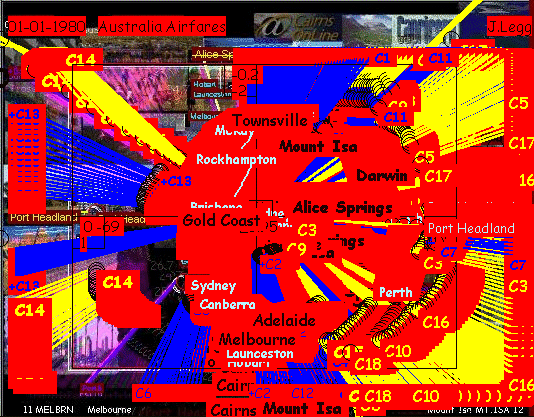
This Option 4 (F4 in inGridX) allows you to explore the grid by examining at will, without reanalyzing, any of the dimensions contained in the grid. The first two dimensions are automatically displayed at the end of Option 3 (F3 analyze grid). You were able with this option to plot one dimension in terms of itself and you got a ranked display. Note: in earlier versions only the names followed by a period "." were significant at this dimension. In inGridX the StrikeThrough text is used. The following is an example with Component 3 stepping on both the X and Y axis.

When the plot is being displayed, overcrowding is overcome by bringing alternate labels to the forefront. Various methods exist to control the rate at which this occurs. In DOS, pressing the TURBO button if you had one or choosing Windows or DOS to alter the display size would effect this rate and 'P/p' would pause the stepping. Pressing any other key in the active plot window other than F3 or 0-9 (which dynamically adjusted the significance threshold in steps of 10%) would return to the main menu. In inGridX the Step scroll bar sets the timing and the Step check tab operated with Next to control the pause.
Part of inGridX's interpretation process is spent looking at the smaller dimensions to see if there is any significant relationship worth commenting on. I normally Ploted 3,3 then 4,4 then 5,5 until there is no significant (highlighted) relationship shown. Capturing the images of dimensions 1&2 along with 1&3 and running them through a morphing program produced a good 3D rotation video. When running a grid that hasn't previously been analyzed, this option would AutoRun the analysis (option 3) right through to end. In inGridX the fun has just begun.
Notes:-
1. The star character "*" in front of the construct name in the first screen (above) remained in place on the second screen (below) and the construct name is still placed outside the box in a line continuing from the center of the box. The star "*" remained to give you an indication of the importance of the construct. (i.e. the greater the distance from the center, the more importance it has). In inGridX the chosen construct label appears in both places with many extra options.
2. The period "." which appeared after either some elements or constructs was an indication that this name had greater than the 70% to the two dimensions being shown. Significance. In DOS you could press for 10%-90% the digits 0-9 and this was useful when the text was captured via Win95 Ms-Dos screen commands Mark, Cut & Paste. On color screens different colors were also used.. In inGridX, StrikeThrough text is used for lower items along with a "+" symbol for those items on the bandwidth cusp and normal to denote higher significance.
3. When using the actual program some names may be 'flashing' on and off with others. This simply means that they occupy close positions on the screen. If a 'P or p' was pressed while these names were flashing the stepping was paused to allow screen capture for later inclusion into Dynamic HTML animated maps. In inGridX the Step and Next command do the same thing.
FURTHER Observations
In defining better what the horizontal axis or vertical axis mean, I believe Dr. Slater was the first to bring together feature labeled interactions into the same hyperspace and this showed up when comparing inGridX to output from various other programs such as XLSTAT.
The 1st horizontal axis or eigenvector, as the principal component could be called, is the hyperplane which explains the most variation through multidimensional space. Represented by the numbers input into the grid, it is an imaginary plane and is made up of a collection of lesser vectors (lines of influence) which are the individual constructs themselves. Thus, it is the overall collection of names at either end of a component line (their distance away from the center and the proximity to the component line) which give meaning to the component or "SUPER CONSTRUCT" name.
Why I aligned the left-right, up-down 'flipping' of the grid to put the greatest weight into the North East quadrant, as opposed to Patrick's original program, was to make the grid able to play its part in a radial link to a superordinate and/or core grid. Like it or not, even the computer needs to know on which side its bread is buttered. More specifically,: imagine an elastic net placed over the hypersphere. Then what you would see is a representation of a biological neuron where the dendrites are the constructs and the firing rates of the synapses are the numbers entered into the grid. The North East corner, therefore, is where the axonal hillock would be. In other words, the morphology of a neuron is determined by its inputs. Beware of finely balanced dilemmas because they can destroy the deciding direction of the North East axon and as in the case of biology a synaptic dilemma disfigures the neuron. A pseudo backfiring then causes the neuron to eventually breakup and disappear. Thus I claim the weight loss in a brain caused by dementia is related partly to conditioned signals or ideas conflicting.
While I am still perfecting my graphics - see a scalable cousin Ingrid Project at NTT - for eigenpicture navigation techniques - see Self Organizing Maps at WEBSOM.
Principal Components can, in grids dealing with
peoples' construct systems, be called "Super Constructs". See Personal
Construct Theory - Kelly 1955; NORTON or Routledge '91 ISBN 0-415-03799-9.
Here's a link to Robin Hill's review "Personal
Construct Theory and Research Method" (Bannister, D. 1981) that helps in
formalizing the structure of a situation.